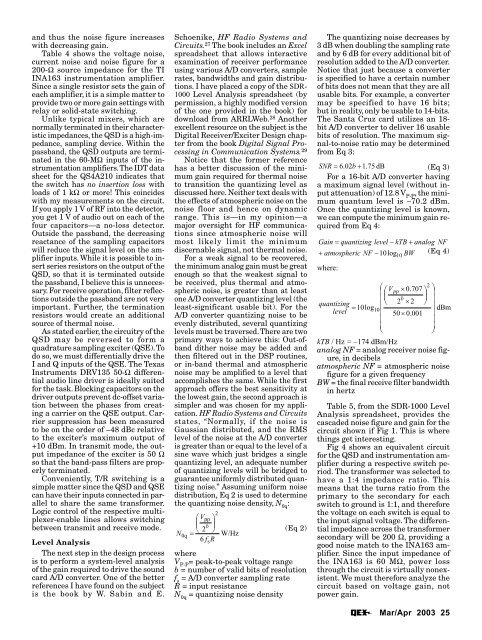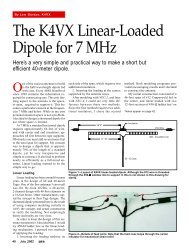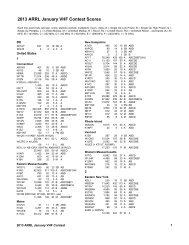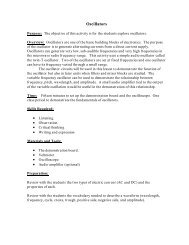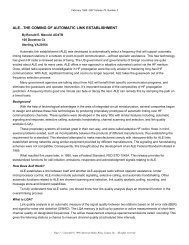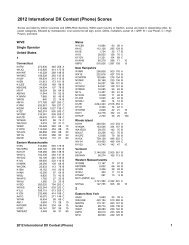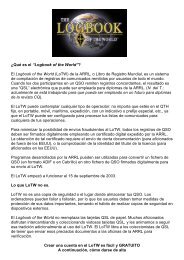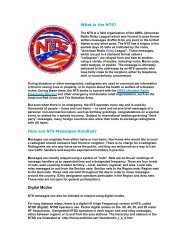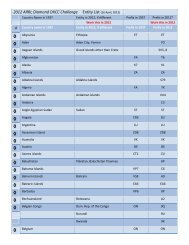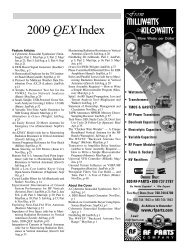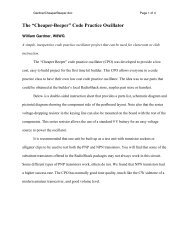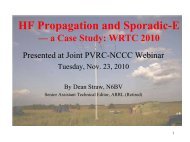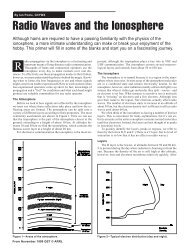A Software Defined Radio for the Masses, Part 4 - ARRL
A Software Defined Radio for the Masses, Part 4 - ARRL
A Software Defined Radio for the Masses, Part 4 - ARRL
Create successful ePaper yourself
Turn your PDF publications into a flip-book with our unique Google optimized e-Paper software.
and thus <strong>the</strong> noise figure increases<br />
with decreasing gain.<br />
Table 4 shows <strong>the</strong> voltage noise,<br />
current noise and noise figure <strong>for</strong> a<br />
200-Ω source impedance <strong>for</strong> <strong>the</strong> TI<br />
INA163 instrumentation amplifier.<br />
Since a single resistor sets <strong>the</strong> gain of<br />
each amplifier, it is a simple matter to<br />
provide two or more gain settings with<br />
relay or solid-state switching.<br />
Unlike typical mixers, which are<br />
normally terminated in <strong>the</strong>ir characteristic<br />
impedances, <strong>the</strong> QSD is a high-impedance,<br />
sampling device. Within <strong>the</strong><br />
passband, <strong>the</strong> QSD outputs are terminated<br />
in <strong>the</strong> 60-MΩ inputs of <strong>the</strong> instrumentation<br />
amplifiers. The IDT data<br />
sheet <strong>for</strong> <strong>the</strong> QS4A210 indicates that<br />
<strong>the</strong> switch has no insertion loss with<br />
loads of 1 kΩ or more! This coincides<br />
with my measurements on <strong>the</strong> circuit.<br />
If you apply 1 V of RF into <strong>the</strong> detector,<br />
you get 1 V of audio out on each of <strong>the</strong><br />
four capacitors—a no-loss detector.<br />
Outside <strong>the</strong> passband, <strong>the</strong> decreasing<br />
reactance of <strong>the</strong> sampling capacitors<br />
will reduce <strong>the</strong> signal level on <strong>the</strong> amplifier<br />
inputs. While it is possible to insert<br />
series resistors on <strong>the</strong> output of <strong>the</strong><br />
QSD, so that it is terminated outside<br />
<strong>the</strong> passband, I believe this is unnecessary.<br />
For receive operation, filter reflections<br />
outside <strong>the</strong> passband are not very<br />
important. Fur<strong>the</strong>r, <strong>the</strong> termination<br />
resistors would create an additional<br />
source of <strong>the</strong>rmal noise.<br />
As stated earlier, <strong>the</strong> circuitry of <strong>the</strong><br />
QSD may be reversed to <strong>for</strong>m a<br />
quadrature sampling exciter (QSE). To<br />
do so, we must differentially drive <strong>the</strong><br />
I and Q inputs of <strong>the</strong> QSE. The Texas<br />
Instruments DRV135 50-Ω differential<br />
audio line driver is ideally suited<br />
<strong>for</strong> <strong>the</strong> task. Blocking capacitors on <strong>the</strong><br />
driver outputs prevent dc-offset variation<br />
between <strong>the</strong> phases from creating<br />
a carrier on <strong>the</strong> QSE output. Carrier<br />
suppression has been measured<br />
to be on <strong>the</strong> order of –48 dBc relative<br />
to <strong>the</strong> exciter’s maximum output of<br />
+10 dBm. In transmit mode, <strong>the</strong> output<br />
impedance of <strong>the</strong> exciter is 50 Ω<br />
so that <strong>the</strong> band-pass filters are properly<br />
terminated.<br />
Conveniently, T/R switching is a<br />
simple matter since <strong>the</strong> QSD and QSE<br />
can have <strong>the</strong>ir inputs connected in parallel<br />
to share <strong>the</strong> same trans<strong>for</strong>mer.<br />
Logic control of <strong>the</strong> respective multiplexer-enable<br />
lines allows switching<br />
between transmit and receive mode.<br />
Level Analysis<br />
The next step in <strong>the</strong> design process<br />
is to per<strong>for</strong>m a system-level analysis<br />
of <strong>the</strong> gain required to drive <strong>the</strong> sound<br />
card A/D converter. One of <strong>the</strong> better<br />
references I have found on <strong>the</strong> subject<br />
is <strong>the</strong> book by W. Sabin and E.<br />
Schoenike, HF <strong>Radio</strong> Systems and<br />
Circuits. 27 The book includes an Excel<br />
spreadsheet that allows interactive<br />
examination of receiver per<strong>for</strong>mance<br />
using various A/D converters, sample<br />
rates, bandwidths and gain distributions.<br />
I have placed a copy of <strong>the</strong> SDR-<br />
1000 Level Analysis spreadsheet (by<br />
permission, a highly modified version<br />
of <strong>the</strong> one provided in <strong>the</strong> book) <strong>for</strong><br />
download from <strong>ARRL</strong>Web. 28 Ano<strong>the</strong>r<br />
excellent resource on <strong>the</strong> subject is <strong>the</strong><br />
Digital Receiver/Exciter Design chapter<br />
from <strong>the</strong> book Digital Signal Processing<br />
in Communication Systems. 29<br />
Notice that <strong>the</strong> <strong>for</strong>mer reference<br />
has a better discussion of <strong>the</strong> minimum<br />
gain required <strong>for</strong> <strong>the</strong>rmal noise<br />
to transition <strong>the</strong> quantizing level as<br />
discussed here. Nei<strong>the</strong>r text deals with<br />
<strong>the</strong> effects of atmospheric noise on <strong>the</strong><br />
noise floor and hence on dynamic<br />
range. This is—in my opinion—a<br />
major oversight <strong>for</strong> HF communications<br />
since atmospheric noise will<br />
most likely limit <strong>the</strong> minimum<br />
discernable signal, not <strong>the</strong>rmal noise.<br />
For a weak signal to be recovered,<br />
<strong>the</strong> minimum analog gain must be great<br />
enough so that <strong>the</strong> weakest signal to<br />
be received, plus <strong>the</strong>rmal and atmospheric<br />
noise, is greater than at least<br />
one A/D converter quantizing level (<strong>the</strong><br />
least-significant usable bit). For <strong>the</strong><br />
A/D converter quantizing noise to be<br />
evenly distributed, several quantizing<br />
levels must be traversed. There are two<br />
primary ways to achieve this: Out-ofband<br />
di<strong>the</strong>r noise may be added and<br />
<strong>the</strong>n filtered out in <strong>the</strong> DSP routines,<br />
or in-band <strong>the</strong>rmal and atmospheric<br />
noise may be amplified to a level that<br />
accomplishes <strong>the</strong> same. While <strong>the</strong> first<br />
approach offers <strong>the</strong> best sensitivity at<br />
<strong>the</strong> lowest gain, <strong>the</strong> second approach is<br />
simpler and was chosen <strong>for</strong> my application.<br />
HF <strong>Radio</strong> Systems and Circuits<br />
states, “Normally, if <strong>the</strong> noise is<br />
Gaussian distributed, and <strong>the</strong> RMS<br />
level of <strong>the</strong> noise at <strong>the</strong> A/D converter<br />
is greater than or equal to <strong>the</strong> level of a<br />
sine wave which just bridges a single<br />
quantizing level, an adequate number<br />
of quantizing levels will be bridged to<br />
guarantee uni<strong>for</strong>mly distributed quantizing<br />
noise.” Assuming uni<strong>for</strong>m noise<br />
distribution, Eq 2 is used to determine<br />
<strong>the</strong> quantizing noise density, N 0q :<br />
N<br />
0q<br />
Vpp<br />
b ⎟<br />
2<br />
6 f R<br />
⎟<br />
⎛ ⎞<br />
⎜<br />
=<br />
⎝ ⎠<br />
s<br />
2<br />
W/Hz<br />
(Eq 2)<br />
where<br />
V P-P = peak-to-peak voltage range<br />
b = number of valid bits of resolution<br />
f s = A/D converter sampling rate<br />
R = input resistance<br />
N 0q = quantizing noise density<br />
The quantizing noise decreases by<br />
3 dB when doubling <strong>the</strong> sampling rate<br />
and by 6 dB <strong>for</strong> every additional bit of<br />
resolution added to <strong>the</strong> A/D converter.<br />
Notice that just because a converter<br />
is specified to have a certain number<br />
of bits does not mean that <strong>the</strong>y are all<br />
usable bits. For example, a converter<br />
may be specified to have 16 bits;<br />
but in reality, only be usable to 14-bits.<br />
The Santa Cruz card utilizes an 18bit<br />
A/D converter to deliver 16 usable<br />
bits of resolution. The maximum signal-to-noise<br />
ratio may be determined<br />
from Eq 3:<br />
SNR = 6 . 02b<br />
+ 1.<br />
75 dB<br />
(Eq 3)<br />
For a 16-bit A/D converter having<br />
a maximum signal level (without input<br />
attenuation) of 12.8 VP-P , <strong>the</strong> minimum<br />
quantum level is –70.2 dBm.<br />
Once <strong>the</strong> quantizing level is known,<br />
we can compute <strong>the</strong> minimum gain required<br />
from Eq 4:<br />
Gain = quantizing level − kTB + analog NF<br />
+ atmospheric<br />
NF −10log10<br />
BW (Eq 4)<br />
where:<br />
⎛ 0.<br />
707 ⎞<br />
⎜ ⎛ Vpp<br />
× ⎞ ⎟<br />
⎜ ⎜<br />
⎟<br />
b<br />
2 2 ⎟<br />
quantizing<br />
10log<br />
⎜<br />
⎝ × ⎠<br />
=<br />
⎟<br />
10<br />
dBm<br />
level ⎜ 50 × 0.<br />
001 ⎟<br />
⎜<br />
⎟<br />
⎜<br />
⎟<br />
⎝<br />
⎠<br />
kTB / Hz = –174 dBm/Hz<br />
analog NF = analog receiver noise figure,<br />
in decibels<br />
atmospheric NF = atmospheric noise<br />
figure <strong>for</strong> a given frequency<br />
BW = <strong>the</strong> final receive filter bandwidth<br />
in hertz<br />
Table 5, from <strong>the</strong> SDR-1000 Level<br />
Analysis spreadsheet, provides <strong>the</strong><br />
cascaded noise figure and gain <strong>for</strong> <strong>the</strong><br />
circuit shown if Fig 1. This is where<br />
things get interesting.<br />
Fig 4 shows an equivalent circuit<br />
<strong>for</strong> <strong>the</strong> QSD and instrumentation amplifier<br />
during a respective switch period.<br />
The trans<strong>for</strong>mer was selected to<br />
have a 1:4 impedance ratio. This<br />
means that <strong>the</strong> turns ratio from <strong>the</strong><br />
primary to <strong>the</strong> secondary <strong>for</strong> each<br />
switch to ground is 1:1, and <strong>the</strong>re<strong>for</strong>e<br />
<strong>the</strong> voltage on each switch is equal to<br />
<strong>the</strong> input signal voltage. The differential<br />
impedance across <strong>the</strong> trans<strong>for</strong>mer<br />
secondary will be 200 Ω, providing a<br />
good noise match to <strong>the</strong> INA163 amplifier.<br />
Since <strong>the</strong> input impedance of<br />
<strong>the</strong> INA163 is 60 MΩ, power loss<br />
through <strong>the</strong> circuit is virtually nonexistent.<br />
We must <strong>the</strong>re<strong>for</strong>e analyze <strong>the</strong><br />
circuit based on voltage gain, not<br />
power gain.<br />
Mar/Apr 2003 25<br />
2


